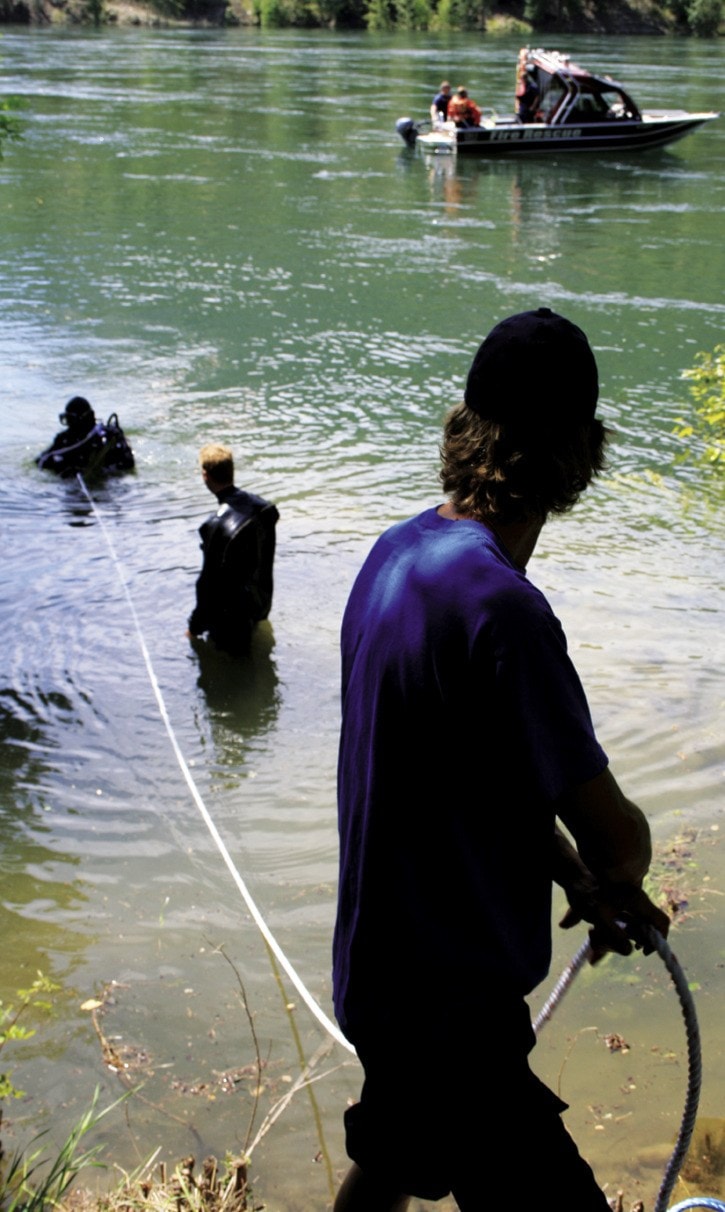They haven’t found Atlantis yet, but near record levels of the Columbia River have regional district staff searching for answers in its depths.
Driving through Rock Island is a typical day for most, but many people don’t realize what important piece of city infrastructure lurks in that area: the Glenmerry pump house.
Taking a hard right into the bushes past Rock Island Wednesday morning brought a group of concerned officials from the regional district down a narrow dirt road that quickly met the rising rapids of the Columbia River and the Glenmerry pump house.
The Glenmerry pump house is part of a regional sewer system facing a serious problem. It is responsible for moving sewage to the water treatment plant from the majority of Greater Trail, but rising water levels threaten to derail dated equipment from within.
Currently, two internal electric motors in the pump house are running on high, instead of the regular one, and prolonged use at that rate could cause a malfunction of the system.
Near record river levels have submerged the pump house’s overflow pipe, forcing river water back into the pump house and overloading the system.
And with the river’s level expected to be high until mid August, the regional district employed a three-man scuba diving team to plug the overflow pipe to prevent a back flow of water, reducing the workload on the pump house and avoiding a potentially costly repair.
“We’re really in uncharted territory here,” Alan Stanley, the director of environmental services at the Regional District of Kootenay Boundary (RDKB), explained from the submerging shoreline.
“Typically, if we run into something like this—and this is a really unusual event—the water would come up and it might infiltrate the overflow pipe and we would just wait it out.
“But in this case, we’ve been advised that the river is going to be at this level or even higher for an extended period of time. So, we have to take extraordinary measures to try to block that flow from coming in through that overflow pipe.”
Sewage is coming into the Glenmerry pump house and flowing at nearly four times the rate that it usually does during the winter season (lowest average).
At almost 29,000 cubic metres per day, the current rate eclipses the winter average of 7,500 cubic metres per day and is significantly higher than the 13,000 cubic metres per day that would flow through the station during spring runoff (highest average).
To put it in layman’s terms, too much sewage is flowing through the Glenmerry pump station each day.
And it could be worse. Without the operation of upstream Columbia River Treaty dams, the peak flow of the Columbia River in Trail would be roughly double its current flow, and within five per cent of the historic maximum flows ever seen in the major pre-dam flood years of 1948 and 1961.
A crew of seven men from the RDKB gathered around the pump station in shorts and T-shirts in the sweltering morning heat to attempt to plug the pipe, while two others began wading into the murky river water in black diving garb.
Diver Andy Gilmore lowered himself into the water and began searching for the pump, but emerged shortly after his departure, taking deep breaths, winded from a current that was “really strong.”
Stanley continued to explain the severity of the problem, indicating that if the RDKB dive team could not find and plug the pump, there could be a risk of internal equipment failure if the internal equipment continued to operate on high for an extended period of time. That situation could cost the regional district—and the taxpayers of the Greater Trail region—if the equipment failed under stress and had to be replaced.
“We would anticipate equipment failures and, at that point, we would probably be in an overflow situation where the sewage materials would … have to be redirected into the river,” Stanley said.
The 37-year-old pump house operating system is currently on the cusp of phase two of the regional district’s liquid waste management plan, but approval has not been secured to move forward with repair of the system.
And with replacement of the pump house equipment likely in phase three of the plan, replacing it now would be an additional cost the regional district would like to avoid, said Stanley.
“If there wasn’t a means to control this beast, we might be in a world of hurt and it would be unimaginable,” Stanley relayed, emphasizing the ripple effect damages that would stem from the possibility of a system failure.
Although the pipe had not been plugged by press time, a diver found the overflow pipe extending into the river had been crushed by the weight of the moving water.
